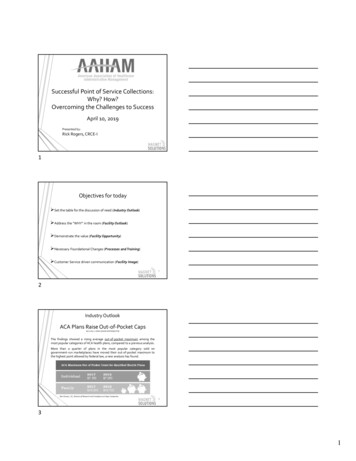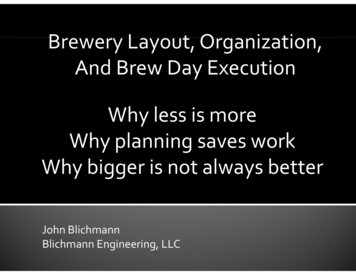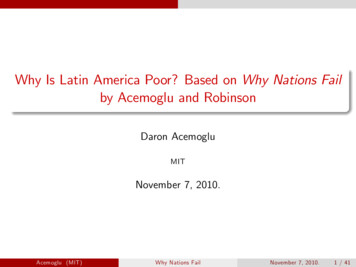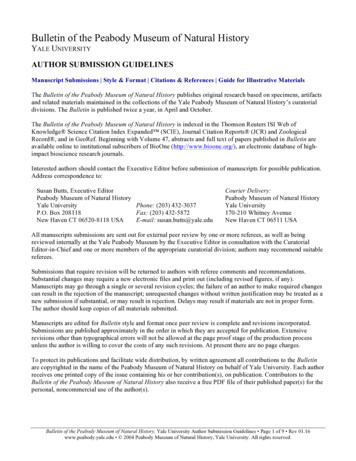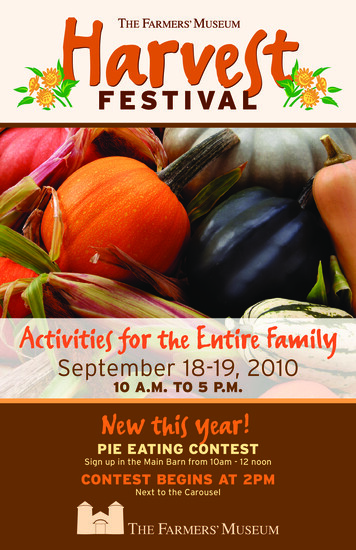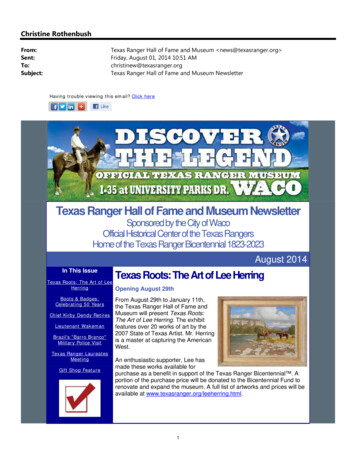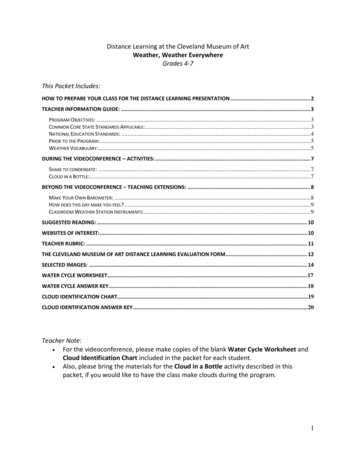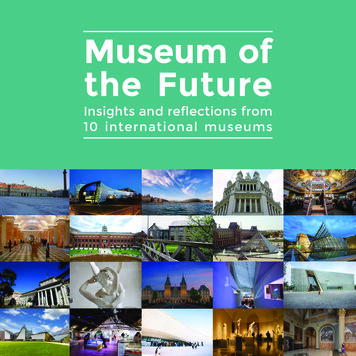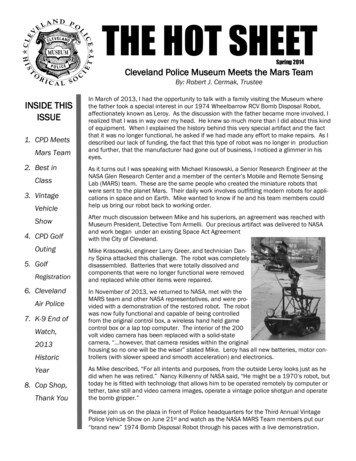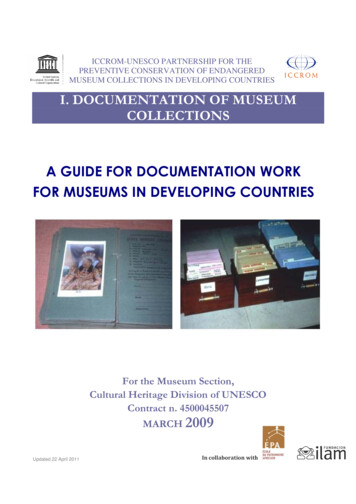
Transcription
ICCROM-UNESCO PARTNERSHIP FOR THEPREVENTIVE CONSERVATION OF ENDANGEREDMUSEUM COLLECTIONS IN DEVELOPING COUNTRIESI. DOCUMENTATION OF MUSEUMCOLLECTIONSA GUIDE FOR DOCUMENTATION WORKFOR MUSEUMS IN DEVELOPING COUNTRIESFor the Museum Section,Cultural Heritage Division of UNESCOContract n. 4500045507MARCH 2009Updated 22 April 2011In collaboration with
DOCUMENTATION OFMUSEUM COLLECTIONS.WHY? HOW?Practical guideAnne Ambourouè Avaro,with the contribution of Gaël de Guichen and Alain Godonou
DOCUMENTATION OFMUSEUM COLLECTIONS.WHY? HOW?Practical guide
DOCUMENTATION OF MUSEUM COLLECTIONS.WHY? HOW?Practical guidePublication:Written by: Anne Ambourouè Avaro (Ecole du Patrimoine Africain – EPA), with the contribution ofGaël de Guichen (ICCROM) and Alain Godonou (Ecole du Patrimoine Africain – EPA)Coordination for ICCROM: Isabelle VergerProofreading: Alain Godonou, Isabelle VergerTranslation: Michael Westlake (English), Claudia Pettinau (Spanish)Layout and cover:Illustrations : Flaubert Meye EdouISBN 2010, UNESCO, ICCROM and EPA
ContentsIntroduction .11- Why document? .22- How to set up a basic manual documentation system fromscratch2-1 Accession number2-2 Accession register2-3 Card catalogue2-4 Location system2-5 Other .4 .4 .5 .6 .7 .83- How to reactivate an abandoned or incomplete manualdocumentation system3-1 A word of warning3-2 Non-exhaustive evaluation of various possible situations3-2-1 Accession number3-2-2 Accession register3-2-3 Card catalogue3-2-4 Location system .9 .9 .9 .9 .10 .11 .124- How to check the inventory .135- How to computerize the system5-1 Standardization of data5-2 Equipment and software .14 .14 .156- How to maintain the documentation system6-1 The registrar6-2 The procedural manual .16 .16 .16Conclusion .18
IntroductionThe ICOM code of ethics (http://icom.museum/ethics.html) and similar texts relating to professionalethics require that museum collections be documented.“Documentation of collections. Museum collections should be documented according to acceptedprofessional standards. Such documentation should include a full identification and description of eachobject, its associations, provenance, condition, treatment and present location. Such data should bekept in a secure environment and be supported by retrieval systems providing access to theinformation by the museum personnel and other legitimate users.” ICOM Code of Ethics, 2006, 2.20Thus, in order to be considered professional and in compliance with the required standards, “ everymuseum should be capable of meeting the minimum standard whether it is a small communitycollection with one or two volunteers or a national institution with scores of staff and many thousandsof visitors”, Jerry Weber, senior adviser, quality standards, MLA (Collections on).It was in order to help small museums and reach the minimum required standard of documentation fortheir collections that UNESCO and ICCROM commissioned two studies from the Ecole du PatrimoineAfricain – EPA. One of these involved making an inventory of the various initiatives that have takenplace over the last 20 years in small museums in sub-Saharan Africa in terms of collectionsdocumentation (manual and/or computerized), the other of reviewing existing documentationresources on the Internet, which could be used by small museums in order to guide them in thecreation or reorganization of their documentation system. All of which in order to provide a useful toolto these museums in the form of a guide.The Guide that we here provide is primarily directed at small museums (having less than 5000objects) with limited resources, but it can also be of use to large establishments, since the principlesare the same. It will allow institutions to have the minimum requirements for a basic documentationsystem – we shall concentrate here on the “administrative” management of collections –, byguiding them toward Internet resources that will enable either to start up a documentation system fromscratch, or to improve the existing system. Most of these Internet resources have been published byEPA-ICCROM, CIDOC, the Museum Documentation Association through its Collections Link portal,the US National Park Service, the French Ministry of Culture, the Canadian Heritage InformationNetwork (CHIN) and the Canadian Conservation Institute (CCI). EPA-ICCROM aide-mémoires havebeen available in paper form for many years and have been put online specially for this project.The procedures shown here are the minimal requirements and are therefore simplified. Eachinstitution will be able, if it so wishes, to adapt them to its own standards, or according to nationalstandards.1
1- Why document?Museums acquire objects and create collections because the objects convey a significant message ormessages. These may be variously historical, religious, economic, technological, and so on. When anobject is moved from its place of origin and its context, its significance is reduced and becomes morereliant on the documentation linked to it.Furthermore, when an object arrives at a museum, it begins a “new life”: it will be studied, positioned,exhibited, restored, loaned and transferred, and will be placed alongside many other objects. It willthus be necessary to identify it in a unique way, and to facilitate the management of every aspect ofthis new life.The value of a collection (whether it be for purposes of research, education or interpretation), its safetyand its accessibility therefore depend to a large extent on the quality of the documentation associatedwith it.Documentation is thus the organization of information.Basic documentation is needed for the “administrative” management of collection. It enables themuseum quickly and effectively to: establish proof of ownership locate a specific object find out the total number of objects making up the collection carry out an inventory establish the (always unique) identity of an object link information to an object access information in an efficient and economical way (saving space, time or effort) contribute to the safety of collection carry out an insurance valuationFrom this basic documentation it is possible to supplement it, if so desired, in order, among otherthings, to understand an object and bring it to life (history, use, social or religious value, etc.) present it in a permanent or temporary exhibition make it of interest to the public or researchers analyze collections with a view to making acquisitions have a record of the acts of conservation/restoration which the objects have undergone plan preventive conservation, organization of stores, etc.Through their experience, museums have developed practices that are to a greater or lesser extentshared.The documents containing information should together form a system, a so-called documentationsystem.A system is defined as “a set of elements related both to each other and to their environment and1organized in accordance with a goal ”.A museum’s documentation system is a set of elements (Accession number, Accession register,manual or computerized files, etc.) that are related to each other and to the museum environment andwhich are organized in order to manage the objects in the museum’s collection. The differentinformation media of a museum’s documentation system are interdependent and enable crossreference searches to be carried out. The information they contain is often duplicated, but organized ina different way.1In Françoise Raynal and Alain Rieunier, Définir des objectifs pédagogiques, 1987, IPNETP-Les NouvellesEditions Africaines, Abidjan2
A documentation system is composed of the following 6 elements:56Index filesManual orcomputerizedLocationsystemHistory Files34Card catalogueAbsolutelynecessary1Accession number onthe objectManualAccession register2The 4 elements in red form the basic documentation on which this guide focuses. In the table below,some examples of their use show the relations between the different elements.System elementsUseProof that an object belongs to g an objectKnowing the total number ofobjects in the collectionCarrying out an inventory orretrospective dexfilesDocumentarydossiersXXAnalyzing the collectionsXLaunching collection campaignsXXDesigning an exhibitionXXDoing researchXXPlanning preventive conservationX3
2- How to set up a basic manual documentation system fromscratch.Once an object has been accepted by a museum, it should be listed as belonging to the collection. Itsregistration consists at a minimum of giving it an Accession number, writing the number on the object,listing the object in the Accession register and assigning it a permanent place in the museum.The following reference points on good documentary practices provide you with the resources tocreate the basics of your documentation system, so as to have the minimum needed for theadministrative management of the collections.2-1 Accession numberThe Accession number identifies each object in thecollection in a unique way. It will never be given to any otherobject. It is the key to accessing all documents comprisingthe museum’s documentation system, because it allowseach object to be linked to the documents referring to it.It should be attached to the object.Existing resources: Aide mémoire for Documentation in museums, n 1, The accession register, § : Accessionnumber, urces/1-Accession register.pdfThe “Accession number” paragraph of this resource provides two accession number formats currentlyin use, as well as the steps to follow for numbering items comprising several parts. Aide mémoire for Documentation in museums, n 2, Brief guide to the manual marking of ts/ressources/2-Marking.pdfPractical advice for marking or labeling objects. Labelling and marking objects, .xmlClear and comprehensive resource, with practical information on how to mark and label objects.Easily printable. Placing registration numbers on paintings and sculptures, CCI notes (Canadian ConservationInstitute), n 1/5, Ottawa, 1994. Application of acquisition numbers on textiles, CCI notes (Canadian Conservation Institute) n 13/8, Ottawa, mYou will find practical information on marking and labeling objects. ICC Notes can be ordered on theICC website or by fax, mail, telephone or e-mail. There is a charge, however. Numbering, Collections Linkhttp://www.collectionslink.org.uk/index.cfm?ct leDownload/trueUseful resource which explains the various possible formats of accession numbers. Running a Museum: a Practical Handbook, Patrick J. Boylan (Ed.), UNESCO-ICOM, p. 141067e.pdfThe paragraph on Numbering and marking of objects in the collection (p.21-22) gives generalinformation on how to mark an artifact.In French: Inventorier des collections de musées, § LES SECRETS DU NUMÉRO D’INVENTAIRE, Ministryof Culture, atiques/fiches/fiche3.htmThis resource makes reference to the DMF (Direction des Musées de France) standards, particularlyin relation to the columns of the Accession register. The accession number format described here isthe three-part format. At the bottom of the document you will find the basic procedure to follow foraffixing the accession number to the object. In French only.4
In Spanish: Lina Nagel Vega. Editora. Manual de Registro y Documentación de Bienes Culturales. DIBAM,GETTY. Chile. a.htm Luis Caballero Zoreda. La documentación museológica. Boletín de la ANABAD, Tomo 38, Nº 4,(1988), pags. ?codigo 798916 Luis Caballero Zoreda. A propósito del "sistema de documentación para museos". Boletín de laANABAD, Tomo 33, Nº 3, (1983), pags. o?codigo 964749If these resources become unavailable, you will be able to find some of them on the EPA ces/number.htm. They were captured in March 2009 and checked in June 2010.2-2 The Accession registerThe accession register is an official administrative document. Allobjects in the collection should be listed in it in chronological orderof accession number.- It proves that the object belongs to the museum- It serves as the basis for setting up the museum’s entiredocumentation system- It is the museum’s memoryIt should be bound in hardback format and its pages should benumbered.Information relating to the object is arranged in columns. Thenumber and names of these columns vary according to themuseum.Two photocopies should be made of the accession register. One,kept in a different place from the original, will be retained as is andregularly updated. The other can be used as a working tool.From the moment you begin describing the objects, attention must be paid to the terms you use, sincethis will be important later, when your museum moves on to computerizing the data (See Section 5,How to computerize the system § 1). This is why we have here included a resource on describingobjects, so that you can begin thinking about the words you will be using. We recommend that youlook at 5-1 where there are further resources that will help your work on the standardized descriptionof your collections. This will enable you to save time when you move on to computerization.Existing resources: Aide mémoire for Documentation in museums, n 1, The accession register, urces/1-Accession register.pdfThis presents the Accession register: format, headings, security. Aide mémoire for Documentation in museums, n 3, Recommendations for the description ofobjects, urces/3-Object description.pdfHere you will find advice on describing objects and on standardization. Aide mémoire for Documentation in museums, n 4, Taking measurements, urces/4-Taking measurements.pdfPractical advice on measuring an object: equipment, units of measurement, procedure. Registration step by step: when an object enters the museum, .xmlRelatively clear and simple overall, although some parts are rather less clear than others. It explains,step by step, the procedure to adopt for registering an object when it arrives at the museum, fromissuing a receipt through the creation of index files. The recommended procedure may be ratherlengthy for what we know of the targeted museums. Accession records, Collections Linkhttp://www.collectionslink.org.uk/index.cfm?ct tId/155/fileDownload/trueThe various steps and documents needed for correct registering of collections. Although referring toMDA practices, this is a good useful resource that may be adapted to the targeted museums ifnecessary. Accessioning, in Museum Handbook, Part II, Museum Records, US National Park Service5
I/mh2ch2firstfile.pdfThis useful resource is in the form of a series of questions and answers referring to situations that aretypically encountered in museums. It is designed for the United States National Park Servicemuseums, hence all the references and instructions concern these. However, there are goodexamples, advice and instructions that can be applied to many museums. Documenting museum collections, in Museum Handbook, Part II, Museum Records, § C and F,US National Park ons/MHII/mh2ch1.pdfThis takes the form of a series of questions and answers. Those concerning the workspace, theequipment and the protection of documents will be useful.In French: Inventorier des collections de musées, § LES SECRETS DU NUMÉRO D’INVENTAIRE, Ministèrede la culture, tiques/fiches/fiche3.htmThis resource presents the characteristics of the Accession register. It makes reference to the DMF(Direction des Musées de France) standards, particularly in relation to the columns of the Accessionregister. The DMF standard requires a “14-column register”. Although rather old (1995), this is auseful resource and a degree of common sense will allow readers to distance themselves in regard tothe DMF standard.In Spanish: Lic. Armando Gagliardi, Ant. Patricia Morales.(Coord). Normativas Técnicas para Museos.Dirección de Museos de Venezuela. Venezuela. Normativas/Normativa3 1.shtmlIf these resources become unavailable, you will be able to find some of them on the EPA ces/register.htm. They were captured in March 2009 and checked in June 2010.2-3 The Card catalogueThe card catalogue, or catalogue, is the basic file of the documentation system. The cards in it areclassified in ascending order of accession number, in the same order as the accession register. Theyshould not be removed from the catalogue. For this reason they are perforated at the bottom and heldin place in the file by a metal bar. These catalogue cards show the location code of the objectconcerned. This is why the card catalogue should not be made publicly available.Existing resources: Aide mémoire for Documentation in museums, n 7, Cards and files, urces/7-Cards files.pdfDefinitions of manual cards and files, description of catalogue cards and index files, separators andclassification system. Registration step by step: when an object enters the museum, .xml, Stage 4Stage 4 gives examples of different headings on the cards of the card catalogue. Cataloguing objects, Collections Linkhttp://www.collectionslink.org.uk/manage information/doc cataloguing/doc cataloguing factsheetDefinition of a Card catalogue, list of the main information to be included in it, suggestions on how tocomplete the cards and on the formats and the classification system.In Spanish: Manuales de Inventario de Bienes de interés Cultural, Desarrollado por: Ministerio de Cultura,Programa de Inventario y Registro del Patrimonio Cultural Colombiano, Dirección de categoria 1821 Guía para el inventario, catalogación y documentación de colecciones de museos:arqueología, arte, etnografía, historia. Ministerio de Cultura, Museo Nacional de Colombia,programa Red Nacional de Museos, Colombia, s/docs/guiainventario.pdf?PHPSESSID b848a65024200492c3de8a0271b10d43 Blanca Noval. Manual para la elaboración de una ficha de identificación de un bien cultural.6
CONACULTA-INAH. México. .mx/texe/manualficha ident.pdf Martha Isabel Tapia Gonzalez. Instructivo para el llenado de la ficha institucional deidentificación de Monumentos Históricos muebles e inmuebles por destino. CONACULTA.INAH. México. b.mx/texe/instruc fichaident.pdf Inventario de Bienes Culturales de la Iglesia en Chile. Manual y Fichas de InventarioMauricio Infante V., y Comisión Nacional de Bienes Culturales de la Iglesia, Conferencia Episcopalde Chile, 2008.http://www.iglesia.cl/bienesculturales/ Isabel Bravo Juega, Normas
Africain – EPA. One of these involved making an inventory of the various initiatives that have taken place over the last 20 years in small museums in sub-Saharan Africa in terms of collections documentation (manual and/or computerized), the other of reviewing existing documentation

